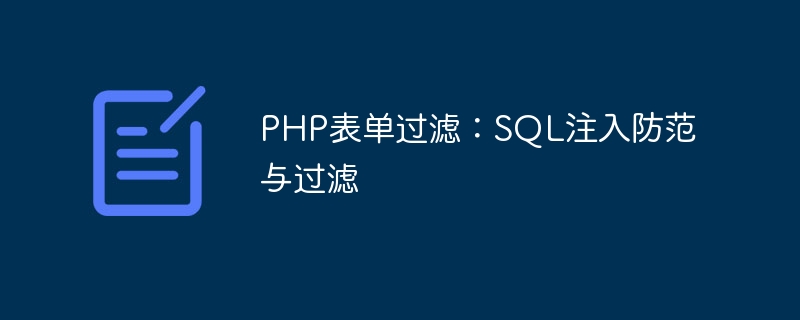

PHP form filtering: SQL injection prevention and filtering
Introduction:
With the rapid development of the Internet, the development of Web applications has become increasingly becoming more and more common. In web development, forms are one of the most common ways of user interaction. However, there are security risks in the processing of form submission data. Among them, one of the most common risks is SQL injection attacks.
SQL injection attack is an attack method that uses a web application to improperly process user input data, allowing the attacker to perform unauthorized database queries. By injecting malicious SQL code into the input box, attackers can obtain, modify, delete or even destroy the data in the database.
In order to prevent SQL injection attacks, we need to properly filter and process user input data. Below, we will introduce some commonly used PHP form filtering methods and provide corresponding code examples.
String filtering is one of the most common form filtering methods. By using PHP's built-in functions or regular expressions, we can filter some special characters and keywords to prevent users from entering malicious code.
1.1 String filtering using PHP’s built-in functions
Sample code:
$name = $_POST['name']; $filtered_name = filter_var($name, FILTER_SANITIZE_STRING);
In the above example, we filtered the name entered by the user through the filter_var function and the FILTER_SANITIZE_STRING option . This option will filter out special characters in the original string.
1.2 Using regular expressions for string filtering
Sample code:
$email = $_POST['email']; $filtered_email = preg_replace('/[^a-zA-Z0-9@.]/', '', $email);
In the above example, we use the preg_replace function and regular expressions to remove uppercase and lowercase letters Characters other than , numbers, @ and . are replaced with empty strings. In this way, we can filter out some special characters to ensure that the email address entered by the user is legal.
Number filtering is used to filter the numerical data input by the user to ensure its legality.
2.1 Numeric filtering using PHP’s built-in functions
Sample code:
$age = $_POST['age']; $filtered_age = filter_var($age, FILTER_SANITIZE_NUMBER_INT);
In the above example, we filtered the age entered by the user using the filter_var function and the FILTER_SANITIZE_NUMBER_INT option. This option will filter out non-numeric characters from the original value.
2.2 Use regular expressions for number filtering
Sample code:
$price = $_POST['price']; $filtered_price = preg_replace('/[^0-9.]/', '', $price);
In the above example, we use the preg_replace function and regular expressions to filter numbers except numbers and. Replace the characters outside the string with an empty string. In this way, we can filter out some special characters and ensure that the price entered by the user is legal.
In addition to filtering the data entered by the user, we also need to take some security measures to prevent SQL injection attacks.
3.1 Using prepared statements
Sample code:
$stmt = $pdo->prepare('SELECT * FROM users WHERE username = :username AND password = :password'); $stmt->bindParam(':username', $username); $stmt->bindParam(':password', $password); $stmt->execute();
In the above example, we use PDO's prepared statements to execute database queries. By using binding parameters, we can avoid directly splicing user-entered data in queries, thereby effectively preventing SQL injection attacks.
Conclusion:
In web development, forms are a very important way of user interaction. However, during the processing of form data, we must be very careful to guard against SQL injection attacks. Through reasonable data filtering and the use of prepared statements, we can ensure that the data entered by users is legal and effectively prevent SQL injection attacks. I hope this article can help you understand PHP form filtering and SQL injection prevention.
Reference:
The above is the detailed content of PHP form filtering: SQL injection prevention and filtering. For more information, please follow other related articles on the PHP Chinese website!
 How to jump with parameters in vue.js
How to jump with parameters in vue.js Introduction to service providers with cost-effective cloud server prices
Introduction to service providers with cost-effective cloud server prices What are the advantages and disadvantages of decentralization
What are the advantages and disadvantages of decentralization What are the requirements for opening a digital currency account? Is it free?
What are the requirements for opening a digital currency account? Is it free? Introduction to linux delete command
Introduction to linux delete command How to connect to the database in vb
How to connect to the database in vb How to convert pdg files to pdf
How to convert pdg files to pdf What's wrong with the air switch tripping?
What's wrong with the air switch tripping?



